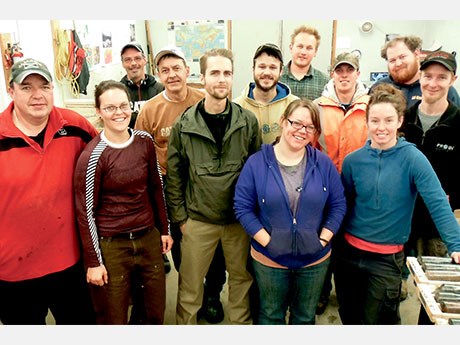Borden Lake wins discovery of the year award
Borden Lake was always a long shot.
Located one kilometre off Highway 101 and only nine kilometres from the town of Chapleau, it was never expected to be anything more than a non-core property Probe Mines could work on when there was a lull in activity at its Black Creek chromite property in the Ring of Fire.
“There were more reasons not to pick up the property than there were to pick it up, but if you squinted, you could see the potential,” said Probe Mines president and CEO David Palmer.
What started out as a sniff of lowgrade gold in the mid-80s is now the most talked about discovery in Northern Ontario.
The area was never thought of as favourable ground for mineral exploration and was largely overlooked.
“It’s in the Kapuskasing Structural Zone,” said Palmer. “The rocks we’re looking at on surface at one time were about 20 kilometres depth, and at 20 kilometres depth you get incredibly high pressures and temperatures. Geologists look at that and say, ‘if there was a gold deposit there, chances are it’s been cooked up, destroyed and remobilized,’ so they stay away from these metamorphic belts.”
On the other hand, added Palmer, “you can’t ignore an outcrop that has gold in it. You have to follow it up.”
Probe Mines and the two prospectors credited with the discovery of Borden Lake – Mike Tremblay and Jack Robert – were recipients of the 2013 Ontario Prospectors Association discovery of the year award at the Ontario Geoscience Symposium in Sudbury November 5 for following up on that original sniff of gold.
Today’s 4.3 million-ounce and growing discovery had its origins in a 1984 outcrop sampling program by Noranda along Highway 101.
“One of the samples came back with a half gram of gold,” said Palmer. “At the end of the day, it wasn’t of interest to them, but they told Mike (Tremblay), and he followed up on it.”
Tremblay staked the property in 1987 and found other showings of gold over the years, but it was only in 2010 that Probe picked it up.
“We had optioned another property from them in the Swayze Belt and Borden Lake came up in conversation one day,” recalled Palmer.
“It kind of piqued my interest, so I went up for a day, looked at it and thought, it’s a lot easier than the Ring of Fire.
Drilling
“It was tough to find drills at the time because the industry was doing so well, but we finished up on another property a little earlier than expected and drilled Borden Lake. We sent the core samples in for assay and, lo and behold, all six holes came back top to bottom with continuous runs of gold.
To save money, we drilled 100-metre to 130-metre holes, so we hadn’t even drilled through the thing.” The initial results were indicative of a low-grade deposit, and the thinking was that all they had to do was build tonnage, but as additional results came in, they realized there was a highergrade core.
“Instead of running one gram, we were seeing 1.5 to 2 grams, and that changed the economics,” said Parker.
“At the time, everybody was looking at bulk tonnage deposits, but the costs were really high. Osisko spent $1 billion (developing its Canadian Malartic Mine on the Quebec side of the Abitibi gold belt) and Detour Lake was climbing to $1.5 billion.”
Borden’s higher-grade core allowed Probe to produce the same number of ounces at a lower CAPEX. “When the price of gold dropped, all these bulk tonnage deposits that had been more worried about tonnage than grade all of a sudden realized that their margins were thin and that they were vulnerable to the price of gold,” said Parker.
Game changer
Then, the real game changer occurred in December 2012.
“We were stepping out 100 metres by 100 metres away from the discovery to expand the deposit. We were up to two kilometres of strike length and our next step-out hole went from one-gram material to 10 grams. It was an order of magnitude jump. It was exactly what the market wanted to see: high grade, low CAPEX, low OPEX and faster payback.
We followed up on that and now we have a kilometre of strike length on the high-grade zone.”
Instead of spending $1.5 billion to develop a 50,000-tonne per day (t/d) operation, Probe can now look at spending $500 million for a 10,000-t/d mine, or even $250 million for a 2,000-t/d operation.
To date, Probe has drilled more than 150,000 metres in 517 holes, not including a winter drill program, which got underway in January with four drills turning.
The most recent assay reports released in January showed intersections grading up to 17.2 grams per tonne.
Probe’s currently reported 4.3 million ounce resource averaging 1.03 g/t gold doesn’t include the recently discovered high-grade zone, but a new resource estimate is in the works.
The company has excellent relations with the three First Nations in the area and over $30 million in the treasury, said Palmer.
A promising orebody, a receptive community and excellent logistics put Probe in a sweet spot.
“We’re bucking the trend. We’re one of the few (exploration) companies with a share price increase this year.”



.jpg;w=120;h=80;mode=crop)